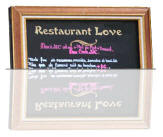Home |
Restaurants by City
|
Food Photography |
Archive | Philosophy |
![]()
Right now we are eating in Seattle, Washington.
|
Tuesday
2006
Permalink
|
Misguided, June 6, 2006 Today I got a call from a reporter. She was writing a story on the topic of a particular tumultuous discussion on eGullet. I unfortunately have not had enough time to keep up with all the sites I'd like to frequent, and eGullet is certainly a high quality site. So I had to go look up the thread to which she was referring. This particular discussion is entitled "Sincerest Form, Interludes after midnight". The topic is essentially a discussion of what's appropriate and inappropriate when it comes to various chefs copying food and dishes from one another. We've had our own brush with this debate here and here on tastingmenu. The brief synopsis is this. During my last trip to Asia I ate at the Tapas Molecular Bar in Tokyo. The meal was a 25 course "molecular gastronomy" survey. The young chef was brand new and had recently come from Mini Bar in Washington, DC. He made it crystal clear to me during the meal that the bulk of the dishes he was serving he'd brought with him from his previous employer where he was not the head chef. I relayed all this information in my write-up along with the fact that I truly enjoyed the meal. Despite his forthrightness, and my conveying his words (both in the write-up and multiple times in the comment stream) some readers sill insisted on beating up on this young chef for ripping off Mini Bar. The first issue is simple. The Chef at Tapas Molecular Bar (name chosen by management, not by him) was completely up front about where his dishes came from. So it's not like he was trying to pass off the dishes as his own unique inventions. But this to me is a footnote in a the context of a much bigger issue. I'll ask you the same question I asked the reporter today: why are the same people who criticize these modern more experimental chefs for borrowing dishes not criticizing every Thai restaurant they go to for serving so many of the same dishes? I'm serious. The problem is not copying. The problem is that we have started to judge food as we judge couture or popular music. And while the latest hit song may be catchy, quickly wildly popular, and hit all the right sugar and fat receptors (as it were), its shelf life is often relatively short. Hit songs are not classics. Classics have staying power. Great food to me is more like classical music or jazz. Does creativity play a role? Of course. But great compositions are honored and revered. Fans go to concerts to hear them faithfully reproduced in both traditional and also updated forms. Jazz musicians can play the same song twenty times with each rendition being both new and fresh as well as faithful to the spirit of the original. The issue is also not about credit. Of course everyone should mention their sources. But wouldn't it be great if we got to a world where mentioning your source was almost irrelevant because everyone was more focused on the quality and consistency with which you materialized the particular dish, and not focused on whether you'd come up with your own personal signature or style. Cuisines across the world have taken decades and sometimes centuries to evolve to their current form. Evolution and experimentation have resulted in perfect combinations of local ingredients. To think that our emphasis should be on asking young (or veteran) chefs to come up with their own styles or genres of cuisine is a misapplication of resources and priorities. Are we that bored of every single dish in existence on the planet that we need new ones created to keep our fragile interest? Don't get me wrong. I'm a fan of creativity. I'd just prefer that we reward chefs primarily for their deep and undivided commitment to quality, flavor, and freshness. Being able to reproduce those qualities at reasonable scale on a consistent basis is a pre-requisite for getting to find your own voice.
I hope some of this makes it into the reporter's story. I'll keep you posted when it comes out.
|
|
Our Sponsors
Free Car Listings Hot Tubs Stools Saunas Bar Stools - Calendar and Event Schedules - Food Events and Calendars - Wine Events and Calendars - Digital Photography Resources - Software for Advertisers - Jewish Gifts and Judaica - Howard Stern Podcast - ponytailed blogger Jonathan Schwartz

Browse tastingmenu
Home |
Restaurants by City X |
Food Photography |
Archive | Philosophy |
![]()
Free eBooks: All About Apples
| Autumn Omakase
More:
Discussion |
Cool Food T-Shirts |
Ingredients
| Markets |
Recipes
Search |
Blog FAQ |
Other
Blogs
Best of tastingmenu
|
City View
Entry: July 6, 2006 |
Blue Plate
Entry: June 19, 2006 |
L'Atelier de Joël Robuchon
Entry: July 18, 2006 |
Browse by City
Boston | Chicago | Houston | Las Vegas | Los Angeles | Maui | New York | Philadelphia | Portland | San Francisco | Seattle | Toronto | Utah | Vancouver | Washington D.C.
Bangkok | Beijing | Hong Kong | Seoul | Tokyo
Amsterdam | Berlin | Italy | London | Madrid | Paris | Vienna
Browse by Month
2006
2005
2004
2003
2002
2001
Comments, questions, or feedback:
info / at / tastingmenu / dot / com
All pages Copyright (c) 2001-2006 tastingmenu.com
Last modified 01/30/07.




